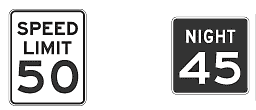More Regulatory Signs (continued)

Intersection Lane Control
Intersection Lane Control signs are an important form of traffic control signage. They are used to regulate the flow of traffic at intersections and are placed in strategic locations to ensure the safety of drivers and pedestrians.
Intersection Lane Control signs are typically used in high-traffic areas, such as city streets and highways. By providing drivers with clear guidance on which lanes to use when approaching an intersection, these signs help to reduce the number of accidents and improve the overall flow of traffic.
The most common type of Intersection Lane Control sign is the “Do Not Cross” sign. This sign is placed near the center of an intersection and is designed to remind drivers that they should not cross the center line of the road. It also serves as a visual warning to other drivers that the intersection is not a safe place to enter.
In addition to the “Do Not Cross” sign, there are other types of Intersection Lane Control signs. These include the “No U-Turn” sign, the “Stop Ahead” sign, and the “Left Turn Only” sign. Each of these signs serves a specific purpose and provides drivers with clear guidance on which lane they should use when approaching an intersection.
Intersection Lane Control signs are generally made of reflective materials so that they can be easily seen by drivers, even at night. The signs are also often placed in areas where they will be seen by pedestrians, such as crosswalks, to ensure that everyone understands the rules of the road.
Overall, Intersection Lane Control signs are an important tool for keeping drivers safe. By providing clear guidance on which lanes to use when approaching an intersection, these signs help to reduce the number of accidents and improve the overall flow of traffic.

Passing and Keep Right
Passing and Keep Right signs are important safety signs that are found along roads, highways, and other areas to help keep traffic safe and orderly. These signs are usually placed on the right side of the road and are used to indicate when it is safe to pass a vehicle or when a driver should keep to the right of the road.
Passing signs are typically used when two vehicles are moving in opposite directions on the same lane or road. A Passing sign indicates that the vehicle in front of you should move to the left side of the road, allowing you to pass safely on the right side. Passing signs are generally found in areas where the lane is wide enough to allow two vehicles to pass each other safely.
Keep Right signs, on the other hand, are used to indicate that drivers should stay to the right side of the road, even when there is no vehicle in front of them. Keep Right signs are commonly found at the start of a two-way street, at the start of a one-way street, and at intersections. They can also be used to indicate when to move over to the right lane in order to allow faster-moving vehicles to pass.
Both Passing and Keep Right signs are important safety signs that are designed to help reduce the risk of accidents and keep traffic flowing smoothly. Drivers should always obey these signs and be aware of them when they are driving. By following these signs, drivers can help ensure that all vehicles on the road are safe and that everyone can get to their destinations safely and on time.
It is also important to note that these signs are not always visible. In some cases, they are obscured by trees, buildings, or other objects. If a driver cannot see a Passing or Keep Right sign, they should use their best judgment as to when to pass or keep to the right of the road.
In summary, Passing and Keep Right signs are important safety signs that should be obeyed at all times. They are designed to help keep traffic safe and orderly, and by following these signs, drivers can help reduce the risk of accidents and ensure that everyone can get to their destinations safely and on time.


















